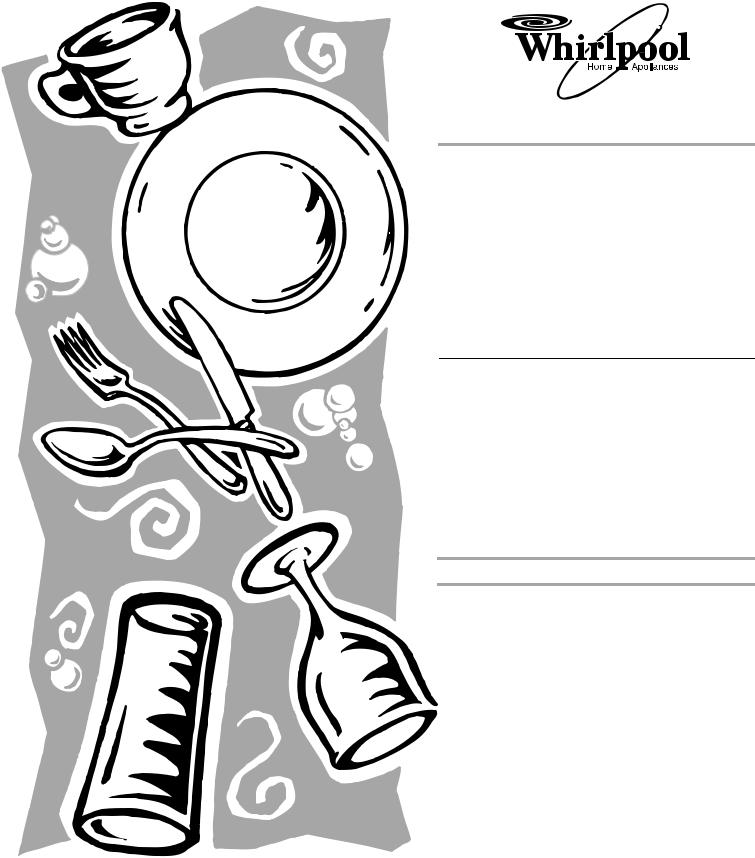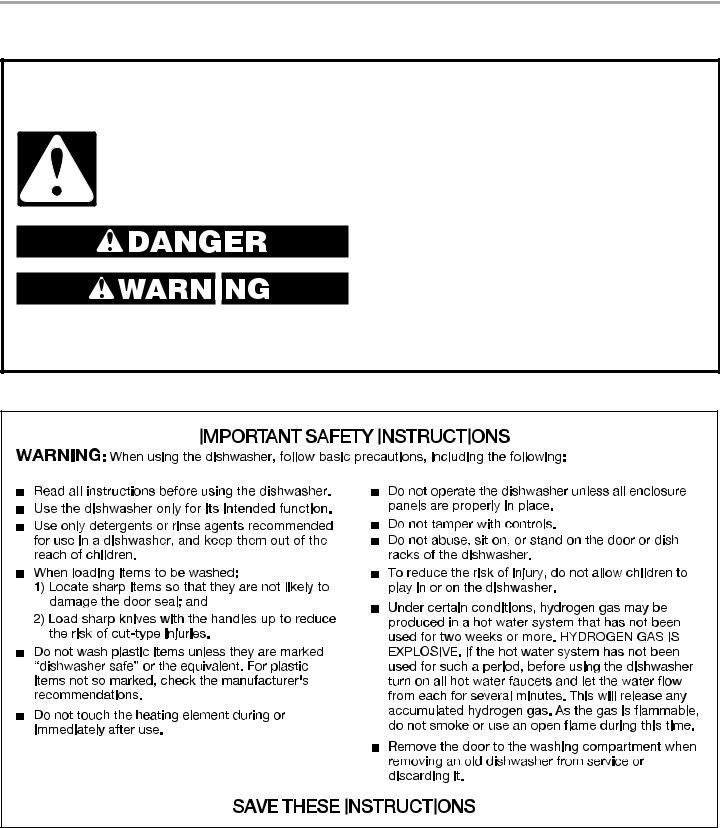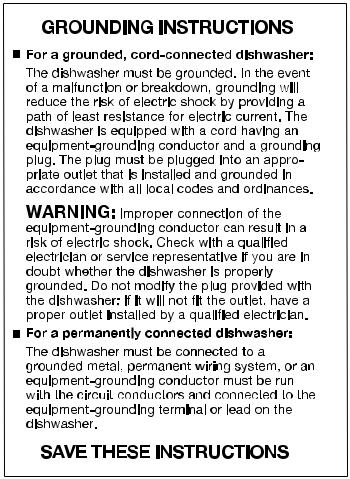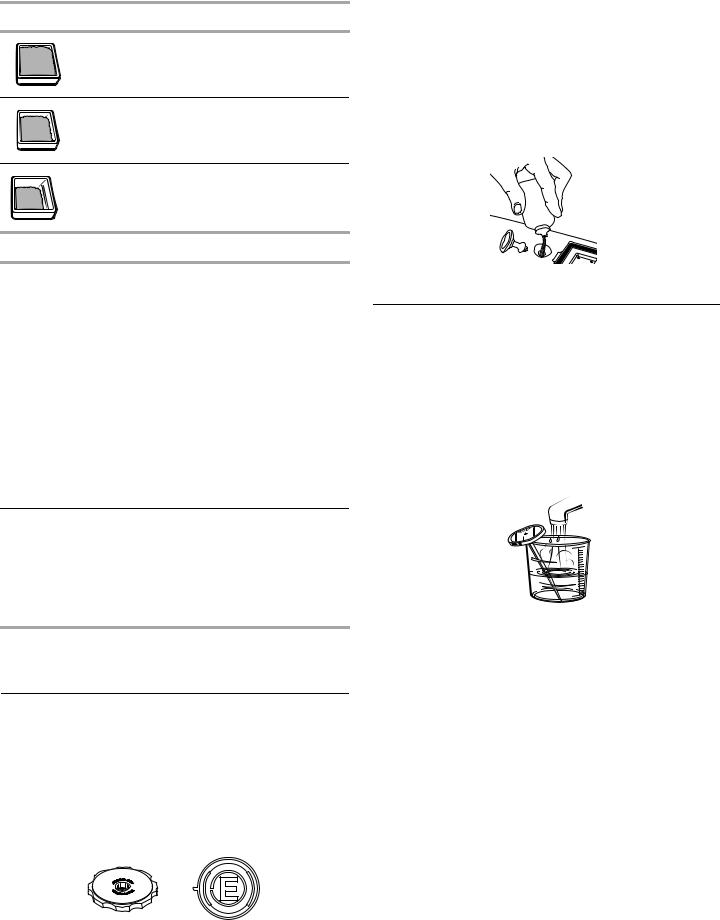Whirlpool DU890DWGT, DU850DWGB, DU810DWGU Owner's Manual

®
UNDERCOUNTER
DISHWASHER
Use&CareGuide
For questions about features, operation/performance, parts, accessories or service call: 1-800-253-1301
In Canada, for assistance call: 1-800-461-5681, for installation and service call: 1-800-807-6777
or visit our website at www.whirlpool.com or www.whirlpool.com/canada
LAVE-VAISSELLE
ENCASTRÉ
Guided’utilisation etd’entretien
Au Canada, pour assistance, composer le 1-800-461-5681, pour installation ou service 1-800-807-6777
ou visitez notre site web à www.whirlpool.com/canada
Table of contents/Table des matières......................................... |
2 |
Model Series 400, 800, 801, 805, 810, 811, 840, 850, 890 8051219A

TABLE OF CONTENTS |
|
DISHWASHER SAFETY.............................................................. |
3 |
PARTS AND FEATURES ............................................................ |
5 |
UNDERCOUNTER START-UP GUIDE ...................................... |
7 |
Using Your New Dishwasher ....................................................... |
7 |
Stopping Your Dishwasher .......................................................... |
7 |
PORTABLE START-UP GUIDE.................................................. |
7 |
Using Your New Dishwasher ....................................................... |
7 |
Stopping Your Dishwasher .......................................................... |
8 |
CONNECTING YOUR PORTABLE DISHWASHER ................... |
8 |
Connecting the Faucet Adapter................................................... |
8 |
Connecting to Water and Electrical Supply................................. |
9 |
Using the Faucet .......................................................................... |
9 |
Disconnecting the Dishwasher .................................................... |
9 |
DISHWASHER LOADING .......................................................... |
9 |
Loading Suggestions ................................................................... |
9 |
Loading the Top Rack................................................................ |
10 |
Loading the Bottom Rack.......................................................... |
10 |
Loading the Silverware Basket .................................................. |
11 |
DISHWASHER USE ................................................................. |
11 |
Detergent Dispenser .................................................................. |
11 |
Rinse Aid Dispenser ................................................................... |
12 |
Dishwasher Efficiency Tips ........................................................ |
12 |
Cycle Selection Chart ................................................................ |
13 |
Canceling a Cycle ...................................................................... |
13 |
Changing a Cycle or Setting ...................................................... |
13 |
Adding Items During a Cycle ..................................................... |
13 |
Option Selections....................................................................... |
14 |
Drying System ............................................................................ |
14 |
Overfill Protection Float.............................................................. |
14 |
WASHING SPECIAL ITEMS ..................................................... |
15 |
DISHWASHER CARE................................................................ |
15 |
Cleaning Your Dishwasher......................................................... |
15 |
Cleaning the Filter Screen.......................................................... |
16 |
Drain Air Gap.............................................................................. |
16 |
Storing Your Dishwasher ........................................................... |
16 |
TROUBLESHOOTING............................................................... |
16 |
ASSISTANCE OR SERVICE ..................................................... |
18 |
In the U.S.A. ............................................................................... |
18 |
In Canada ................................................................................... |
18 |
WARRANTY .............................................................................. |
19 |
TABLE DES MATIÈRES |
|
LA SÉCURITÉ DU LAVE-VAISSELLE ...................................... |
21 |
PIÈCES ET CARACTÉRISTIQUES ........................................... |
23 |
GUIDE D’INSTALLATION SOUS COMPTOIR ......................... |
25 |
Utilisation de votre nouveau lave-vaisselle................................ |
25 |
Arrêt du lave-vaisselle ................................................................ |
25 |
GUIDE D’INSTALLATION DE L’APPAREIL MOBILE .............. |
25 |
Utilisation de votre nouveau lave-vaisselle................................ |
25 |
Arrêt du lave-vaisselle ................................................................ |
26 |
CONNEXION DU LAVE-VAISSELLE ........................................ |
26 |
Connexion de l’adaptateur pour robinet.................................... |
26 |
Connexion à la source d’eau et d’alimentation électrique ........ |
27 |
Utilisation du robinet .................................................................. |
27 |
Déconnexion du lave-vaisselle................................................... |
27 |
CHARGEMENT DU LAVE-VAISSELLE .................................... |
28 |
Suggestions de chargement ...................................................... |
28 |
Chargement du panier supérieur ............................................... |
28 |
Chargement du panier inférieur ................................................. |
29 |
Chargement du panier à couverts ............................................. |
29 |
UTILISATION DU LAVE-VAISSELLE ....................................... |
30 |
Distributeur de détergent ........................................................... |
30 |
Distributeur d’agent de rinçage.................................................. |
31 |
Conseils d’efficacité pour le lave-vaisselle ................................ |
31 |
Tableau de sélection de programme ......................................... |
32 |
Annulation d’un programme ...................................................... |
32 |
Changement d’un programme ou réglage ................................ |
33 |
Addition de vaisselle durant un programme.............................. |
33 |
Sélection d’options..................................................................... |
33 |
Système de séchage.................................................................. |
34 |
Dispositif de protection contre débordement............................ |
34 |
LAVAGE D’ARTICLES SPÉCIAUX ........................................... |
34 |
ENTRETIEN DU LAVE-VAISSELLE.......................................... |
35 |
Nettoyage du lave-vaisselle ....................................................... |
35 |
Nettoyage de l’écran de filtre..................................................... |
35 |
Dispositif anti-refoulement ......................................................... |
35 |
Remisage du lave-vaisselle........................................................ |
36 |
DÉPANNAGE............................................................................. |
36 |
ASSISTANCE OU SERVICE...................................................... |
38 |
Aux États-Unis............................................................................ |
38 |
Au Canada.................................................................................. |
38 |
GARANTIE................................................................................. |
39 |
2

DISHWASHER SAFETY
Your safety and the safety of others are very important.
We have provided many important safety messages in this manual and on your appliance. Always read and obey all safety messages.
This is the safety alert symbol.
This symbol alerts you to potential hazards that can kill or hurt you and others.
All safety messages will follow the safety alert symbol and either the word “DANGER” or “WARNING.” These words mean:
You can be killed or seriously injured if you don't immediately follow instructions.
You can be killed or seriously injured if you don't follow instructions.
All safety messages will tell you what the potential hazard is, tell you how to reduce the chance of injury, and tell you what can happen if the instructions are not followed.
3

■Install where dishwasher is protected from the elements. Protect against freezing to avoid possible rupture of fill valve. Such ruptures are not covered by the warranty. See “Storing Your Dishwasher” in the “Dishwasher Care” section for winter storage information.
■Install and level dishwasher on a floor that will hold the weight, and in an area suitable for its size and use.
■Remove all shipping plugs from hoses and connectors (such as the cap on the drain outlet) before installing. See Installation Instructions for complete information.
4

PARTS AND FEATURES
This manual covers several different models. The dishwasher you have purchased may have some or all of the parts and features listed below.
1 |
14 |
|
7 |
2 |
|
|
8 |
3 |
|
|
9 |
4 |
10 |
|
|
5 |
11 |
|
|
|
12 |
6 |
|
|
13 |
1. |
Top rack |
7. |
Spray tower and protector |
12. |
Detergent dispenser |
2. |
Water inlet opening |
8. |
Model and serial number label |
13. |
Rinse aid dispenser |
3. |
Bottom rack |
9. |
Silverware basket |
Other features your dishwasher may |
|
4. |
Rack bumper |
10. |
Spray arm |
have |
|
5. |
Heating element |
11. |
Overfill protection float |
14. |
Third level wash |
6. |
Vent |
|
|
|
|
Series 400
5

Series 800, 801 and 805
Series 810 and 811
Series 840
Series 850
Series 890
6

UNDERCOUNTER
START-UP GUIDE
Before using your dishwasher, remove all hang tags, temporary labels, and packaging materials. Read this entire Use and Care Guide. You will find important safety information and useful operating tips.
UsingYourNewDishwasher
1.Scrape large food soil and hard items (toothpicks or bones) from dishes.
2.Properly load the dishwasher. (See “Loading Your Dishwasher.”) Make sure nothing prevents the spray arm(s) from spinning freely.
3.Add detergent and check the rinse aid dispenser. Add rinse aid if needed. (See “Using Your Dishwasher.”)
4.Push door firmly closed. The door latches automatically. Run hot water at the sink nearest your dishwasher until the water is hot. (See “Dishwasher Efficiency Tips.”) Turn off water.
5. Select a drying option.
NOTE: Use Air Dry for the Rinse Only cycle.
6.For Series 840, 850 and 890: Press the desired cycle and option selections. (See “Using Your Dishwasher.”) Turn the Cycle Control knob to the desired cycle to start.
StoppingYourDishwasher
You can stop your dishwasher anytime during a cycle.
1.Open the door slightly.
2.Wait for the spraying action to stop. Then open the door all the way, if needed.
3.Close the door to continue the cycle.
OR
1.Turn the Cycle Control knob slowly clockwise until you hear water draining. Let the dishwasher drain completely.
2.Open the door.
3.Turn the Cycle Control knob to OFF.
PORTABLE
START-UP GUIDE
Before using your dishwasher, remove all hang tags, temporary labels, and packaging materials. Read this entire Use and Care Guide. You will find important safety information and useful operating tips.
UsingYourNewDishwasher
 WARNING
WARNING
Electrical Shock Hazard
Plug into a grounded 3 prong outlet.
Do not remove ground prong.
Do not use an adapter.
Do not use an extension cord.
Failure to follow these instructions can result in death, fire, or electrical shock.
A power supply of 120 volts, 60 Hz AC, 15 or 20 amps, is required.
1.Plug into a grounded 3 prong outlet.
2.Scrape large food soil and hard items (toothpicks or bones) from dishes.
3.Properly load the dishwasher. (See “Loading Your Dishwasher.”) Make sure nothing prevents the spray arm(s) from spinning freely.
7

4.Add detergent and check the rinse aid dispenser. Add rinse aid if needed. (See “Using Your Dishwasher.”)
5.Push door firmly closed. The door latches automatically. Run hot water at the sink where you will connect dishwasher until water is hot. (See “Dishwasher Efficiency Tips.”) Turn off the water and hook the dishwasher to the faucet. (See “Connecting Your Dishwasher.”) Turn on the hot water.
6.Press the desired cycle and option selections. (See “Using Your Dishwasher.”) Turn the Cycle Control knob to the desired cycle to start.
StoppingYourDishwasher
You can stop your dishwasher anytime during a cycle.
1.Open the door slightly.
2.Wait for the spraying action to stop. Then open the door all the way, if needed.
3.Close the door to continue the cycle.
OR
1.Turn the Cycle Control knob slowly clockwise until you hear water draining. Let the dishwasher drain completely.
2.Open the door.
3.Turn the Cycle Control knob to OFF.
Preparing the faucet
1.Remove the screen holder or aerator, screen, and washer from the end of the faucet.
2.Use the faucet adapter kit that came with your portable dishwasher to modify the faucet where the dishwasher will be used.
1.Washer
2.Screen
3.Screen holder or aerator
NOTE: Remove and save the washer, screen, and screen holder or aerator for future use.
Connecting the faucet adapter to faucets with external threads
Insert the two screens and then the thin washer from the faucet adapter kit into the faucet adapter. Attach the adapter onto the end of the faucet.
1.Thin washer
2.Screens
3.Faucet adapter
NOTE: Do not use the thick washer.
Connecting the faucet adapter to faucets with internal threads
Insert the 2 screens, the thin washer, and then the thick washer from the faucet adapter kit into the faucet adapter. Attach the adapter onto the end of the faucet.
CONNECTING YOUR
PORTABLE DISHWASHER
|
1. |
Thick washer |
|
|
2. |
Thin washer |
|
ConnectingtheFaucetAdapter |
3. |
Screens |
|
4. |
Faucet adapter |
||
|
|||
NOTE: A special adapter must be installed on the faucet before |
NOTE: Use both washers. |
||
the dishwasher can be connected. Complete Installation |
|
|
|
Instructions and the adapter are packed with your dishwasher. |
|
|
|
(See the Installation Instructions). |
|
|
|
When moving your dishwasher make sure the door is latched.
Hold the dishwasher at the top front corners.
8

ConnectingtoWaterandElectricalSupply
1.Run water at the faucet until it is hot. Turn the water off.
2.Pull the hoses out of their storage compartment on the back of the dishwasher.
NOTE: Make sure the hoses are not kinked or twisted. Kinked hoses reduce washing performance.
3.Pull down on the locking collar while lifting the hose connector onto the faucet adapter.
1.Faucet adapter
2.Locking collar
3.Hose connector
4.When the connector snaps into place, release the locking collar.
5.Turn the hot water on slowly until it is all the way on.
6.Plug into a grounded 3 prong outlet.
UsingtheFaucet
You can draw water from the faucet while the dishwasher is connected.
NOTE: Do not draw water while the dishwasher is filling or while water is being pumped out. (This helps prevent a low fill when dishwasher is filling or mixing drain water with fresh water when dishwasher is draining.)
Press the red button on the hose connector to draw water from the faucet. (The faucet is set on hot. Adjust the faucet for the water temperature you want.)
NOTE: Turn the hot water back on after you draw water from the faucet. Turn off the cold water.
DisconnectingtheDishwasher
1.Turn the hot water off. (This can be done after the last rinse.)
2.Press the red button on the connector to release the water pressure.
1.Faucet adapter
2.Locking collar
3.Red button
4.Hose connector
3.Lift slightly on the hose connector while pulling down the locking collar. Pull down on the connector.
4.Empty any remaining water from the connector by turning the connector upside-down.
5.Unplug the power supply cord and return it to the storage compartment.
6.Return the hoses to the storage compartment.
DISHWASHER LOADING
LoadingSuggestions
■Remove leftover food, bones, toothpicks and other hard items from the dishes. It is not necessary to rinse the dishes before putting them in the dishwasher. The wash module removes food particles from the water. The module contains a chopping device which will reduce the size of food items.
NOTE: If hard items such as fruit seeds, nuts, and egg shells enter the wash module, you might hear chopping, grinding, crunching, or buzzing sounds. These sounds are normal when hard items enter the module. Do not let metallic items (such as pot handle screws) get into the wash module. Damage can occur.
■Load dishes so soiled surfaces face the spray (down or inward). It is important for the water spray to reach all soiled surfaces.
■Load dishes so they are not stacked or overlapping if possible. For best drying, water must be able to drain from all surfaces.
■Make sure pot lids and handles, pizza pans, cookie sheets, etc., do not interfere with the spray arm rotation.
■Run a rinse cycle to keep dishes moist if you do not plan to wash them soon. Foods like eggs, rice, pasta, spinach, and cooked cereals may be hard to remove if they are left to dry over a period of time.
Quiet operating tips
To avoid thumping/clattering noises during operation:
■Make sure lightweight load items are secured in the racks.
■Make sure pot lids and handles, pizza pans, cookie sheets, etc., do not touch interior walls or interfere with the rotation of the spray arm.
■Load dishes so they do not touch one another.
NOTE: For built-in models, keep sink drain plugs closed during dishwasher operation to prevent noise transfer through drains.
9

LoadingtheTopRack
The top rack is designed for cups, glasses, and smaller items. (See recommended loading patterns shown.)
NOTE: The features on your dishwasher rack may vary from the drawings shown.
Do not cover third level wash (on some models). See arrow.
Cup and glass load
Mixed load
■Place items so open ends face down for cleaning and draining.
■Load glasses and cups in top rack only. The bottom rack is not designed for glasses and cups. Damage can occur.
■Place cups and glasses in the rows between prongs. Placing them over the prongs can lead to breakage.
■To avoid chipping, do not let stemware touch other items.
■China, crystal, and other delicate items must not touch each other during dishwasher operation. Damage can occur.
■Wedge lightweight items against one another or overlap them with heavier dishes.
■Load plastic items securely in the top rack only. Wash only plastic items marked “dishwasher safe.”
■Small bowls, pans, and other utensils can be placed in the top rack. Load bowls in the center section for best stability.
LoadingtheBottomRack
The bottom rack is designed for plates, pans, casseroles, and utensils. Items with cooked-on or dried-on food should be loaded with soiled surfaces facing inward to the spray. (See recommended loading patterns shown.)
NOTE: The features on your dishwasher rack may vary from the drawings shown.
Do not cover spray tower. See arrow.
Mixed load
■Do not load glasses, cups, or plastic items in the bottom rack. Load small items in the bottom rack only if they are secured in place.
■Load plates, soup bowls, etc., between prongs and facing inward to the spray.
■Overlap the edges of plates for large loads.
■Load soup, cereal, and serving bowls in the rack in a variety of ways depending upon their size and shape. Load bowls securely between the rows of prongs. Do not nest bowls because the spray will not reach all surfaces.
Utensil load
■Load cookie sheets, cake pans, and other large items at the sides and back. Loading such items in front can keep the water spray from reaching the detergent dispenser and silverware basket.
■Secure heavily soiled cookware face down in the rack.
■Make sure pot handles and other items do not stop rotation of the spray arm(s). The spray arm(s) must move freely.
■Do not load items between the bottom rack and the side of the dishwasher tub. You can block the water inlet opening.
NOTE: If you have removed the bottom rack for unloading or cleaning, replace it with the bumpers in front.
10

LoadingtheSilverwareBasket
Load the silverware basket while it is in the bottom rack or take the basket out for loading on a counter or table.
NOTE: Unload or remove the basket before unloading the racks to avoid spilling water droplets on the silverware.
Style 1
(on some models)
Style 2
(on some models)
Mix items in each section of the basket with some pointing up and some down to avoid nesting. Spray cannot reach nested items.
IMPORTANT: Always load sharp items (knives, skewers, forks, etc.) pointing down.
NOTES:
■Do not load silver or silver-plated silverware with stainless steel. These metals can be damaged by contact with each other during washing.
■Some foods (such as salt, vinegar, milk products, fruit juices, etc.) can pit or corrode silverware. Run a rinse cycle if you do not have a full load to wash immediately.
■For Series 805 model: When using both silverware baskets, place one in the front of the lower rack and one in the bottom of the lower rack.
DISHWASHER USE
DetergentDispenser
The detergent dispenser has 2 sections. The Pre-Wash section empties detergent into the dishwasher when you close the door.
1. |
2. |
3. |
4. |
1.Cover
2.Main wash section
3.Cover latch
4.Pre-wash section
The Main Wash section automatically empties detergent into the dishwasher during the main wash. (See the “Cycle Selection Chart.”)
■Use automatic dishwashing detergent only. Other detergents can produce excessive suds that can overflow out of the dishwasher and reduce washing performance.
■Add detergent just before starting a cycle.
■Store tightly closed detergent in a cool, dry place. Fresh automatic dishwasher detergent results in better cleaning.
NOTE: Do not use detergent with a rinse cycle.
Filling the dispenser
1.If the dispenser cover is closed, open the cover by pushing the Cover latch.
2.Fill the Main Wash section with detergent. See “How Much Detergent to Use.”
3.Close the Main Wash dispenser cover. Fill the Pre-Wash section if needed.
It is normal for the cover to open partially when dispensing detergent.
NOTE: Use both sections for cycles with 2 washes. Use only the covered section for cycles with 1 wash. See the “Cycle Selection Chart” for more details.
How much detergent to use
■The amount of detergent to use depends on the hardness of your water and the type of detergent. If you use too little, dishes won’t be clean. If you use too much in soft water, glassware will etch.
■Water hardness can change over a period of time. Find out your water’s hardness by asking your local water department, water softener company, or county extension agent.
■Different brands of dishwasher detergent have different amounts of phosphorous for softening water. If you have hard water and use a detergent with a phosphorous content of less than 8.7%, you might need to use more detergent, or use a detergent with a phosphorous content higher than 8.7%.
11

Where to fill
Top of 3rd step (3 tbs or 45 g)
Top of 2nd step (2 tbs or 30 g)
|
Top of 1st step (1 tb or 15 g) |
Water Hardness |
Amount of Detergent |
Soft to Medium Hard Water
0 to 6 grains per gallon
For normally soiled loads
■Fill the Main Wash section to the top of the 2nd step (2 tbs or 30 g)
■Fill the Pre-Wash section to the top of the 2nd step (2 tbs or 30 g) if needed
NOTE: Add only 1 tb or 15 g of detergent to both sections if dishes are pre-rinsed or the water is very soft (0 to 2 grains per gallon).
For heavily soiled loads
■Fill the Main Wash section to the top of the 3rd step (3 tbs or 45 g)
■Fill the Pre-Wash section to the top of the 2nd step (2 tbs or 30 g)
Medium to Hard |
For normally soiled and |
Water |
heavily soiled loads |
7 to 12 grains per |
■ Fill the Main Wash section to the |
gallon |
top of the 3rd step (3 tbs or 45 g) |
|
■ Fill the Pre-Wash section to the |
|
top of the 2nd step (2 tbs or 30 g) |
|
if needed |
NOTE: Fill amounts shown are for standard powdered detergent. Amounts may vary if you use liquid or concentrated powdered detergent. Follow instructions on the package when using liquid dishwasher detergent or concentrated powdered detergent.
RinseAidDispenser
Rinse aids prevent water from forming droplets that can dry as spots or streaks. They also improve drying by allowing water to drain off of the dishes during the final rinse by releasing a small amount of the rinse aid into the rinse water. Your dishwasher is designed to use a liquid rinse aid. Do not use a solid or bar-type.
Checking the dispenser
Check the center of the Fill Indicator cap. Clear means it needs filling.
OR
Or you can remove the Fill Indicator cap. If an “E” is visible, the dispenser is empty.
Filling the dispenser
The rinse aid dispenser holds 6 oz (175 mL) of rinse aid. Under normal conditions, this will last for about three months. You do not have to wait until the dispenser is empty to refill it. Try to keep it full, but be careful not to overfill it.
1.Make sure the dishwasher door is completely open.
2.Remove the Fill Indicator cap.
3.Add rinse aid. Fill to the smallest opening in the lower part of the dispenser. Overfilling can cause the rinse aid to leak out, and could cause oversudsing.
4.Clean up any spilled rinse aid with a damp cloth.
5.Replace the Fill Indicator cap. Close tightly.
DishwasherEfficiencyTips
Hot water dissolves and activates the dishwashing detergent. Hot water also dissolves grease on dishes and helps glasses dry spot-free. For best dishwashing results, water must be at least 120°F (49°C) as it enters the dishwasher. Loads may not wash as well if the water temperature is too low.
To check water temperature
1.Run hot water at the faucet closest to your dishwasher for at least 1 minute.
2.Place a candy or meat thermometer in a glass measuring cup.
3.Check the temperature on the thermometer as the water is running into the cup.
4.If the water temperature at the faucet is below 120°F (49°C), have a qualified person raise the water heater’s thermostat setting.
■To save water and energy, do not rinse dishes before putting them into the dishwasher.
■Use a low energy, quick, or short cycle whenever possible. These cycles use less hot water and energy than the Normal cycle.
■Use a delay feature (on some models) to run your dishwasher during off-peak hours. Local utilities recommend avoiding heavy usage of energy at certain times of day.
■During the summer, run your dishwasher at night to reduce daytime heat buildup.
■Use an air dry, or an energy-saving dry option whenever possible. Allow longer drying times (overnight) when using these options. Use a rinse aid to improve drying.
■Use cycles or options that add extra heat to the wash or rinse portion of the cycle only when needed.
■Run your dishwasher with full loads. Run a rinse cycle after meals until the dishwasher is full.
12
